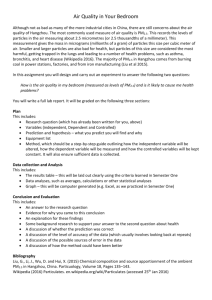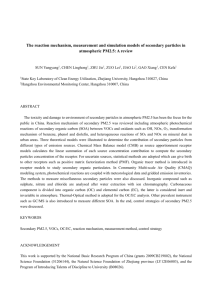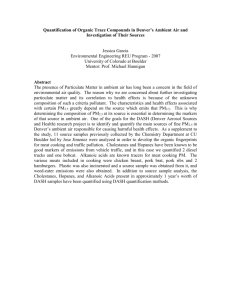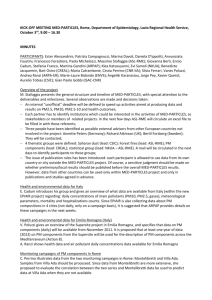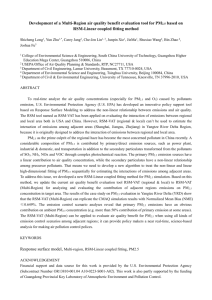Monitoring of Particulate Matter in Alberta
advertisement
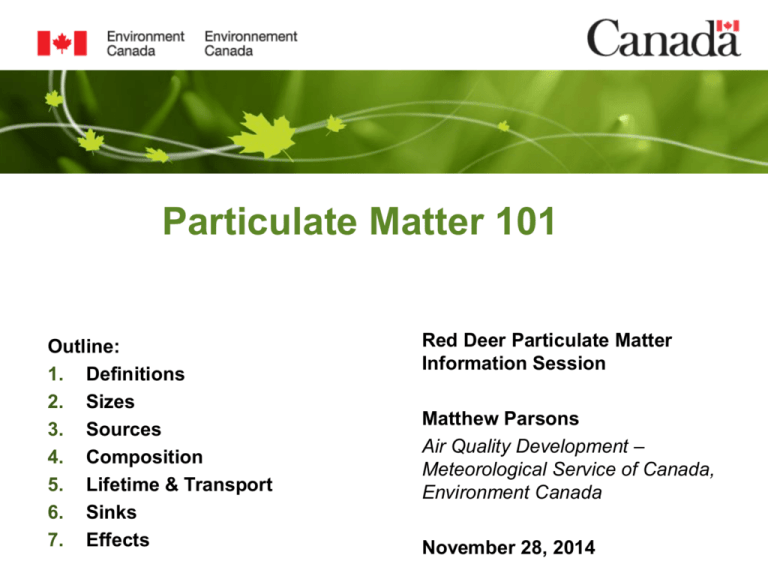
Particulate Matter 101 Outline: 1. Definitions 2. Sizes 3. Sources 4. Composition 5. Lifetime & Transport 6. Sinks 7. Effects Red Deer Particulate Matter Information Session Matthew Parsons Air Quality Development – Meteorological Service of Canada, Environment Canada November 28, 2014 What is Particulate Matter? Soot Organic Material Pollen Mineral Dust • Particulate Matter (PM) – Microscopic solid or liquid particles suspended in the atmosphere – Often expressed in terms of mass per unit volume (e.g., μg/m3 ). Page 2 – November 28, 2014 What is Particulate Matter? Lifetime & Transport Composition Size Source Page 3 – November 28, 2014 Sizes Nano Ultrafine Fine PM2.5 PM10 TSP Page 4 – November 28, 2014 Coarse Sources • Primary PM: – PM emitted directly to the atmosphere. • Secondary PM: – PM formed in the atmosphere through chemical reactions of gases. Pollutant Gases Secondary PM • PM and precursor gases can be from both natural and anthropogenic sources. Page 5 – November 28, 2014 Composition Alberta’s Capital Region PM2.5 Ammonium Sulphate 30 PM2.5 Concentration / µg m-3 Ammonium Nitrate Organic Material 25 Elemental Carbon Soil & Trace Elements 20 Sodium Chloride Particle Bound Water 15 10 5 0 Cold Season Non-event Cold Season Event Warm Season Non-event Event: PM2.5 concentration ≥ 20 µg m-3 Non-event: PM2.5 concentration < 20 µg m-3 Page 6 – November 28, 2014 Warm Season Event Warm Season: April – September Cold Season: October - March Lifetime & Transport • Atmospheric lifetimes for PM is in the range of hours • (>10µm) to weeks (<1µm). Transport of PM is driven by meteorological conditions (e.g., wind, atmospheric stability). – PM can be transported horizontally in the atmosphere over long ranges. – Vertical transport of PM between atmospheric layers is limited. Page 7 – November 28, 2014 Red Deer Sinks Wet Deposition Page 8 – November 28, 2014 Dry Deposition Growth 2011 International Comparison Sofia Warsaw Rome Brussels Lyon Berlin Barcelona Amsterdam Paris Hamburg Prague London Pittsburgh Chicago RED DEER Madrid Phoenix Houston Milwaukee Washington CALGARY Boston MONTRÉAL EDMONTON Seattle Stockholm Denver TORONTO OTTAWA/GATINEAU Environment Canada, Air and Climate Indicators, (2014) Sydney http://ec.gc.ca/indicateurs-indicators VANCOUVER 0 5 10 15 20 Annual Average PM2.5 Concentration / µg Page 9 – November 28, 2014 25 m-3 30 2012 Provincial Comparison Red Deer - Riverside Crescent Heights Edmonton - East Albian Mine Site Hinton Edmonton - McIntyre Calgary - Northwest Edmonton - Centre Drayton Valley Lamont Fort McKay South Anzac Evergreen Park Redwater Patricia McInnes Smoky Heights Caroline Edson Powers Genesee Environment Canada, Air and Climate Indicators, (2014) Tomahawk http://ec.gc.ca/indicateurs-indicators 0 2 4 6 8 Annual Average PM2.5 Concentration / µg Page 10 – November 28, 2014 10 m-3 12 Red Deer Annual Averages Annual Average PM2.5 Concentration / µg m-3 18 Red Deer - Riverside National Average 2015 Standard (CAAQS) 16 14 12 10 8 6 4 2 0 2003 2004 2005 2006 2007 2008 Year Page 11 – November 28, 2014 2009 2010 2011 2012 Environment Canada, Air and Climate Indicators, (2014) http://ec.gc.ca/indicateurs-indicators Why does Particulate Matter Matter? Health Visibility Air Quality Health Index (AQHI) 1 Risk: 2 3 Low (1 – 3) 4 5 6 7 Moderate (4 – 6) • Plant health • Soil/water nutrient balance and toxicity Page 12 – November 28, 2014 8 High (7 – 10) 9 10 + Very High (Above 10) • Corrosion enhancement • Climate effects Monitoring of Particulate Matter in Alberta Red Deer Particulate Matter Information Session Shelley Morris shelley.morris@aemera.org How PM2.5 is measured in Alberta? • Continuous monitoring – In-direct measurement of mass concentration – Short time resolution (one-hour or less) – Provide concentrations on site • Filter based monitoring – Typically integrated over 24 hours – Direct measurement of mass concentration – Laboratory analysis required • Mass concentration • Chemical composition Passive Monitoring • Passive samplers – – – – Parameter SO2 H2S NO2/NOx O3 Detection Limit 0.1 ppb 0.02 ppb 0.1 ppb 0.1 ppb Cost effective and easy to operate Measures H2S, SO2, NO2 and O3 Requires lab analysis Can be deployed for various time periods, typically 30 days as in the PAMZ network – Pollutant concentration is reported over a longer time period than continuous monitors – Common tool for determining spatial and temporal trends Speciation Monitoring • Speciation monitoring – Typically integrated over 24 hours – Direct measurement of mass concentration – Laboratory analysis required • Mass concentration • Chemical composition PM2.5 mass and trace metals PM2.5 organic and elemental carbon PM2.5 sulfate, nitrate and other ions PM2.5 elements PM2.5 Measurement and Water • Continuous analyzers – Do not distinguish between • particulate matter mass and • mass of particle bound water – Want to measure only particulate matter • Thus sample needs to be conditioned – i.e. remove particle bound water • In the past – Conditioning meant heating sample – Results in the loss of semi-volatile fraction • Thus excessive heating can – Result in under reporting particle mass concentration Continuous PM2.5 Monitoring • Various continuous methods – Optical analyzers – Tapered Element Oscillating Microbalance – Beta-attenuation • Relies on physical and optical change • Sample is pre-conditioned • Temperature controlled environment SHARP 5030 TEOM-FDMS BAM-1020 TEOM-SES GRIMM Filter Based Monitoring • Direct measurement of particle mass – Based on filter mass before and after sample collection – Filter conditioned pre weighing • Installed in ambient environment – Sample is drawn though Size selection inlet and through the filter • Used as a reference method – Against which indirect monitors are compared FRM vs FEM • Federal Reference Method (FRM) – “method of sampling and analyzing the ambient air for an air pollutant”* – Typically an “Intermittent Sample” – Examples: Hi-Vol sampler, Dichot PM10/2.5 Partisol • Federal Equivalency Method (FEM) – – “method for measuring the concentration of an air pollutant in ambient air”* Continuous PM2.5 monitors *from 40 CFR 53.1 FEM Equivalent PM 2.5 Monitors Instrument Designation Number Environment s.a. MP101M PM2.5 Beta Attenuation Monitor EQPM-1013-211 Grimm Model EDM180 EQPM-0311-195 Horiba APDS - 371 EQPM-0308-170 Met One BAM 1020 (FEM Version) EQPM-0308-170 Met One BAM 1022 (Real Time) EQPM-1013-209 Thermo Scientific FH62C14-DHS Continuous, 5014i EQPM-0613-189 Opsis SM200 EQPM-0812-203 SWAM 5a Dual Channel Monitor EQPM-0912-204 Teledyne 602 Beta Plus Particle Measurement System EQPM-0912-204 Thermo Scientific 5030 and 5030i Sharp EQPM-0609-184 Thermo Scientific 1400a with 8500C FDMS, 1405 F TEOM EQPM-0609-181 Thermo 1405 DF Dichot with FDMS EQPM-0609-182 Tisch Environmental TE-EDM 180 PM2.5 EQPM-0311-195 FDMS TEOM (Filter Dynamics Measurement System Tapered Element Oscillating Microbalance) • Near real-time averaging • Available in PM2.5 or PM10 • Measurement technology only used in Thermo TEOM products • Higher operating cost • More prone to negative data • Large footprint • Non-FDMS TEOMs do not account for semi volatile particulate. FDMS TEOM Principle of Operation Grimm EDM 180 • • • • Laser based measurement No heating used in RH control Moisture control using Nafion dryer Capable of PM10, PM2.5, and PM1 simultaneously and in real-time. • Able to determine particulate count at 31 size fractions • Low maintenance and operating cost • No size selective inlet required Grimm EDM 180 Grimm Principle of Operation • Optical spectrometer using 90o light scattering • All particles in sample stream measure and classified into 31 different size fractions Beta Attenuation Monitors (BAM) • • • • • Mainstay of ambient particulate monitoring Several variations by different manufacturers Reliable, low operating cost First FEM PM2.5 monitor Minimal Heating for RH control – “smart heater” is turned on by a relative humidity sensor • Only capable of 1 hr averaging – no 1 min data • Beta attenuation noisy over short averaging periods Met One BAM 1020 BAM 1020 Principle of Operation • Low-level 14C (Carbon-14) radiation source uses beta-ray attenuation and a filter tape system • The mass density of particulate on the filter is calculated from the measured reduction in the number of beta particles passing through the filter. • The BAM 1020 is a reference instrument for PM10 Thermo Sharp 5030 & 5030i Synchronized Hybrid Ambient Real-time Particulate Monitor 5030 SHARP • Combines Beta-ray Attenuation and a Nephalometer technologies • Real-time values • Stability and Accuracy of Beta Attenuation combined with rapid measurements of nephelometer • Light scattering photometer is continuously calibrated by beta attenuation mass sensor • Intelligent Moisture Reduction (IMR) System heating the inlet tube; threshold is set at 35% SHARP 5030 Principle of Operation • Generates a Hybrid measurement by combining Beta Attenuation with PM measurements from a Nephelometer • Nephelometer senses light scattered by aerosol passing through illuminated beam Operational Changes • TEOM without FDMS is not a US EPA Federal Equivalent Method • Over the course of 2009, many PM2.5 TEOM monitors were upgraded with FDMS units. • These units better capture volatile components that were previously lost • Both monitors run side-by-side at Edmonton McIntyre. – On average, 4-5 µg/m3 higher on hourly basis. – 98th percentile 24-hour values approximately 10-15 µg/m3 higher. Operational Challenges • A number of stations in different Airsheds have experienced difficulty maintaining reliable operation with the TEOM-FDMS . – – – – Large hour-to-hour swings in reported concentrations Hours lost to negative values High Maintenance hours High cost of replacement/consumable parts • Differences were observed between units • SHARP 5030 monitors have recently been deployed in the network Management Action Plan – Red Deer • TEOM-SES upgraded with FDMS unit in 2009 • SHARP 5030 was installed at Red Deer in August 2013 – Collocated with TEOM-FDMS • A combination of updated monitors and increased smog activity may have led to the sharp increase in PM2.5 concentrations in 2010. • The source apportionment of particulate matter in the Region is complex and not thoroughly understood. PM2.5 Monitors in the Province • 51 Continuous PM2.5 Monitors – – – – – – – 11 TEOM @ 40oC 13 TEOM FDMS @ 30oC (4 Thermo 1405F models) 1 TEOM SES @ 30oC 8 BAM 1020 (Beta Attenuation Monitor) 16 SHARP (Synchronized Hybrid Ambient Real-time Particulate) 1 GRIMM 1 E-BAM • Various methods used within the province • The question is .. Are all methods reporting a comparable sample? The Need For Comparable Method • National Pollution Surveillance Program – Adopted the USEPA Federal Equipment Method analyzers to equip associated stations • Federal Equipment Method analyzers – Compare similarity against a reference method (filter based) – More capable of accounting for the semi-volatile fraction • Within the province – Not all PM2.5 analyzers fall within this class • At this time we are encouraging operators – To purchase FEM equipment when replacing analyzers Thank you Ambient Air Quality Management for PM2.5 in Alberta CASA PM & O3 / CAAQS / Assessments Red Deer Particulate Matter Information Session Maxwell Mazur Maxwell.mazur@gov.ab.ca Canada-wide Standards (CWS) • June 2000 – Canadian Council of Ministers of the Environment established the Canada-wide Standards for fine particulate matter and ozone. – PM2.5: 30 ug/m3 based on three-year average 98th percentile 24-hour average • Applies to Census Metropolitan Areas (CMAs) and Census Agglomerations (CAs) – Ex) Edmonton and Calgary CMAs (> 100 000) – Ex) Red Deer CA (< 100 000) Alberta’s PM and Ozone Management Framework • 2003 – Clean Air Strategic Alliance developed the Particulate Matter and Ozone Management Framework • The Framework is Alberta’s implementation plan for CWS – committed to annual assessments – based on Keeping Clean Areas Clean – proactive management PM2.5 and Ozone Management Framework urveillance Actions Baseline Monitoring and Data Gathering Management Level Red Existing Regulatory and Management Tools anagement Plan Flexible Management Tools Mandatory Plan to Reduce elow CWS Stringent Management Tools tion Levels Exceedance Trigger (CWS) Orange Planning Trigger Blue Surveillance Trigger Green Ozone Daily max 8h (ppb) PM2.5 24h (µg m-3) Mandatory Plan to Reduce Below CWS 65 30 Management Plan Action Level 58 20 Surveillance Actions -- 15 Baseline Monitoring and Data Gathering Canadian Ambient Air Quality Standards (CAAQS) • CAAQS to replace CWS in 2015 • Formally agreed to on Oct 11, 2012 • CAAQS Framework modeled after Alberta’s Framework – Standards and thresholds more stringent than Alberta’s Framework – Introduces a new annual PM2.5 standard • First report to be released in late 2014 – based on 2011-13 data Canadian Ambient Air Quality Standards (CAAQS) Framework • Modeled after the CASA PM and Ozone Framework Management Level Ozone Daily max 8h (ppb) 2015 Red 2020 PM2.5 Annual (µg m-3) 2015 2020 PM2.5 24h (µg m-3) 2015 2020 Actions for Achieving Air Zone CAAQS Threshold (CAAQS) 63 Orange Actions for Preventing CAAQS Exceedance Threshold Yellow Threshold Green 62 56 10.0 8.8 6.4 28 27 19 Actions for Preventing AQ Deterioration 50 4.0 10 Actions for Keeping Clean Areas Clean CAAQS Framework CASA Framework Annual Assessments – History to Date • Alberta Environment and Sustainable Resource Development has committed to CASA to perform annual assessments of PM2.5 and ozone to determine action levels. • First assessment was for 2001 - 2003 period. – Resulted in Edmonton, some parts of West Central and Fort Saskatchewan areas; Red Deer; and Calgary being assigned to the Management Plan action level for ozone. – Subsequent assessments have shown Red Deer, Calgary to have dropped out of Management Plan action level for Ozone but “once you’re in, you’re in.” • Assessments for CMAs with multiple stations based on spatial average – CMAs with some high stations may be classified into lower management levels Annual Assessments – Assessment Methods • Involves analysing specifics of each event over the triggers. – Ex) Back-trajectories, Forest fire activity, Source regions, Meteorology, Levels of other substances • Natural, Background, and Transboundary influences are removed from final assessed values. Forest Fires and Back Trajectories for air parcel arriving at Edmonton on 19 Aug 2010 at 18:00 MDT. Monitors 500 700 850 920.605 Annual Assessment Demo Step 1: Calculate 24-Hour Average Values Aug 14: 6.2 μg/m3 Aug 15: 8.0 μg/m3 Aug 16: 12.0 μg/m3 Aug 17: 9.8 μg/m3 Aug 18: 13.2 μg/m3 Aug 19: 159.6 μg/m3 Aug 20: 87.5 μg/m3 Aug 21: 73.2 μg/m3 Aug 22: 37.1 μg/m3 Aug 23: 21.4 μg/m3 Aug 24: 15.9 μg/m3 Aug 25: 16.6 μg/m3 Data from Edmonton in August 2010 Annual Assessment Demo Step 2: Rank Daily Values from High to Low 1 Aug 14: 6.2 μg/m3 2 Aug 15: 8.0 μg/m3 3 Aug 16: 12.0 μg/m3 4 Aug 17: 9.8 μg/m3 5 Aug 18: 13.2 μg/m3 6 Aug 19: 159.6 μg/m3 7 Aug 20: 87.5 μg/m3 8 Aug 21: 73.2 μg/m3 9 Aug 22: 37.1 μg/m3 10 Aug 23: 21.4 μg/m3 11 Aug 24: 15.9 μg/m3 12 Aug 25: 16.6 μg/m3 98th Percentile – 8th highest Annual Assessment Demo Step 3: Analyse and Remove Events 1 Aug 19: 159.6 μg/m3 Forest Fire Smoke 2 87.5 μg/m3 73.2 μg/m3 Forest Fire Smoke 3 Aug 20: Aug 21: 4 Jan 29: 67.9 μg/m3 Wintertime Smog 5 Feb 24: 59.1 μg/m3 Wintertime Smog 6 Jan 28: 57.9 μg/m3 Wintertime Smog 7 Jan 19: 56.9 μg/m3 Wintertime Smog 8 Dec 6: 47.8 μg/m3 Wintertime Smog 9 Dec 7: 46.4 μg/m3 Wintertime Smog 10 Jan 20: 11 Mar 1: 12 May 18: 44.0 μg/m3 43.8 μg/m3 39.9 μg/m3 Forest Fire Smoke Wintertime Smog Wintertime Smog Not Analysed Annual Assessment Demo Step 4: Recalculate Annual 98th Percentile 1 Aug 19: 159.6 μg/m3 2 Aug 20: 87.5 μg/m3 3 Aug 21: 73.2 μg/m3 4 Jan 29: 67.9 μg/m3 5 Feb 24: 59.1 μg/m3 6 Jan 28: 57.9 μg/m3 7 Jan 19: 56.9 μg/m3 8 Dec 6: 47.8 μg/m3 9 Dec 7: 46.4 μg/m3 10 Jan 20: 11 Mar 1: 12 May 18: 44.0 μg/m3 43.8 μg/m3 39.9 μg/m3 98th Percentile Annual Assessment Results PM2.5 – 2008-2010 2008-10 Assessment for Particulate Matter (PM2.5) Fort Chipewyan (background, transboundary and natural influences removed) Fort McKay Syncrude UE-1 Fort McMurray - Patricia McInnes Evergreen Park CWS Exceedance Action Level Management Plan Action Level Surveillance Action Level Monitoring Action Level Fort McMurray - Athabasca Valley Anzac ✱ Smokey Heights Grande Prairie Cold Lake Beaverlodge CITY of EDMONTON Central ✱ South Fort Saskatchewan ✱ Lamont ✱ Edson Powers Elk Island Tomahawk Drayton Valley Genesee EDMONTON Red Deer Northwest Data not available Caroline Squares represents the Edmonton and Calgary Census Metropolitan Areas (CMAs). Asterisk (✱) indicates incomplete data set. East CALGARY Medicine Hat ✱ Lethbridge Central ✱ East CITY of CALGARY ✱ Annual Assessment Results PM2.5 – 2009-2011 Annual Assessment Results Red Deer Riverside • Prior to 2008 – 2010 assessment period, PM2.5 was below Management Plan action level. • 2009 – 2011 assessment indicated that Red Deer Riverside was at the Mandatory Plan action level. – Within the Edmonton CMA, some stations exceed, however, the CWS applies to the CMA, therefore Edmonton remained in achievement. PM2.5 Concentration (ug/m3) 35.0 30.0 25.0 20.0 15.0 Red Deer Riverside CWS assessments (2001-2012) Exceedance Trigger Planning Trigger Surveillance Trigger 10.0 5.0 0.0 01-03 02-04 03-05 04-06 05-07 06-08 Assessment Period 07-09 08-10 09-11 10-12 Transition to CAAQS: Take-home Messages • CAAQS Framework – – – – modeled after AB Framework; proactive lower thresholds Annual PM metric added Red Deer riverside would not meet hourly or annual average CAAQs based on 2010-2012 – If included in LUF regional plans, would have a regulatory mechanism for implementing CAAQS (previously no regulatory backstop) The Parkland Airshed Management Zone and Particulate Matter Red Deer PM2.5 Information Session November 28, 2014 What is PAMZ? • PAMZ is a non-profit society that monitors air quality and manages air quality issues in west central Alberta • Comprised of representation from all three stakeholder groups – Industry, Government, & Public/NGO • Approximately 50 member organizations and a dozen public members at large • Operating Guidelines: – Openness and Transparency – Inclusiveness and Collaboration – Consensus Decision-making • Has a formal process for identifying and addressing air quality issues (monitoring, workshops, CASA, etc.) • Formed in 1997, began monitoring in 1999 • 3rd of 9 Provincial Airshed Zones • 42,000 km2, 2014 pop. estimate 273,000 Continuous Monitoring Passive Monitoring Air Quality Monitoring Program • 4 Continuous Stations – Each w/ SO2, TRS, NO2-NO-NOX, O3, THC-CH4, PM2.5 (Red Deer H2S & CO, NO TRS) – 2 Permanent • Red Deer (urban) & Caroline (rural) – 2 Portables • Martha Kostuch and David McCoy • Respond to stakeholder issues, fills geographic (towns > 5,000) and technical data gaps • 35 Station Zone-Wide Passive Monitoring Network – SO2, NO2 and O3 PAMZ Passive Air Quality Monitoring Sites PAMZ Air Quality Monitoring Sites (ALL) www.pamz.org PAMZ and PM 2000 2005 - Began Monitoring PM10 and PM2.5 at Caroline & the Martha Kostuch Portable using Automated Dichotomous Filter-Based Monitor (Partisol 2025) operated on a 6-Day NAPS Schedule - Replaced Partisols at Caroline & Martha with BAM 1020 Semi-Continuous PM2.5 Monitor (Hourly Average based on 55 minutes) The Met One Instruments Model BAM-1020 was the first instrument to obtain U.S. EPA Federal Equivalent Method (FEM)designation for continuous PM2.5 monitoring - Added BAM 1020 to David McCoy Portable - Took over Red Deer Riverside Station Operations from ESRD which included a TEOM 1400 PM2.5 Monitor PAMZ and PM 2007 2009 2010 - ESRD replaced TEOM 1400 with TEOM SMS, no collocated monitoring period (monitor needed by ESRD elsewhere) - No discernable change in PM2.5 levels associated with the TEOM changeover - ESRD replaced TEO SMS with TEOM FDMS, no collocated monitoring period (monitor needed by ESRD elsewhere) - Recommended that City of Red Deer ‘s Environmental Master Plan use the CASA PM2.5 Framework management trigger (20 µg/M3) based on 2006-08 CWS assessment and preliminary 2007-2009 estimate - Suspected we may have a step-change in PM2.5 levels but was not confirmed until a detailed examination of wintertime PM2.5 exceedance events was conducted in the fall of 2010 TEOM SMS TEOM FDMS PAMZ and PM 2011 - Commissioned NOVUS Study to better understand higher average PM2.5 levels at Riverside and high PM2.5 episodes observed in winters of 2010 and 2011 - NOVUS study focused on impact of Civic Yards relocation – bus barns and increased vehicle traffic - Recognized there was probably an impact from changeover to the TEOM FDMS, but without collocated monitoring over the winters of 2010 and 2011 could only infer from collocation studies at other sites (Edmonton South) - Began pursuing a 2nd monitoring site for Red Deer in a primarily residential area away from the River Valley and any local influences from the Civic Yards and Riverside Industrial Park Pre 2009 Post 2009 Novus Study • “Overall, the impact on the Riverside Dr. monitoring station due to increased vehicular traffic attributed to the re-location of the Red Deer Civic Cards is an increase in particulate emissions of 13 to 20%. • “The combined effect of buses and increase in traffic caused an increase in maximum hourly and daily PM2.5 concentrations at the monitoring station, particularly in the wintertime.” • “The modeled seasonal variation patterns of PM2.5 levels are aligned with the FDMS PM2.5 measurement.” • The study did not look at changes in PM2.5 levels associated with changeover from TEOM SMS to TEOM FDMS PAMZ and PM 2012 2013 - Began continuous monitoring at Lancaster Site to determine site’s suitability for permanent site (David McCoy November 2012 – March 2013, Martha Kostuch July 2013 – March 2014) - Some correlation between Riverside and Lancaster winter exceedance events and monitoring at PAMZ’s Innisfail and Crossfield-Carstairs monitoring locations - Replaced TEOM FDMS PM2.5 monitor at Red Deer Riverside with Sharp 5030 (FDMS unit still operating at station for collocated monitoring study) Preliminary results - TEOM FDMS hourly average reads 2.7 µg/M3 higher than Sharp 5030 Exceedance Trigger Planning Trigger Surveillance Trigger PAMZ and PM 2014 Future - Heavily involved in development of ESRD PM2.5 Response - Replacing BAM 1020 at Caroline with Sharp 5030 (December) - Establishing 2nd permanent station in Red Deer at Lancaster - Application approved Nov 12, decision advertised Nov. 14, appeal period ends today, tentative installation week of Dec 1 - Fencing, landscaping & permanent power installation will be accomplished in Spring 2015 - Implement any actions assigned to PAMZ by the PM2.5 Response Plan -Closely monitor PM2.5 levels at Riverside and Lancaster sites - Replace BAM1020 at Lancaster with Sharp 5030 - Speciation study of PM at Riverside and/or Lancaster? Lacombe Site PAMZ in 2014 • Maintain operation of PAMZ continuous and passive air quality monitoring networks • Establish 2nd permanent station in Red Deer at Lancaster • Assisting AESRD on development of PM2.5 Response – PAMZ Technical Working Group, PAMZ Communications Committee, ESRD Advisory Group • Continuing implementation of PAMZ Ozone Management Plan (Year 6) • Maintaining its public education and outreach programs – – – – Action Hero Awards - June 4 (Clean Air Day) Held a Vehicle Emissions Testing Clinic in Red Deer - June 4 Maintained Martha Kostuch Education Scholarship - Alex Johnson) Photo Contest (Nov 30 Deadline)


